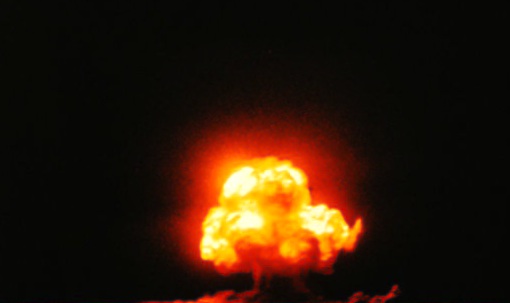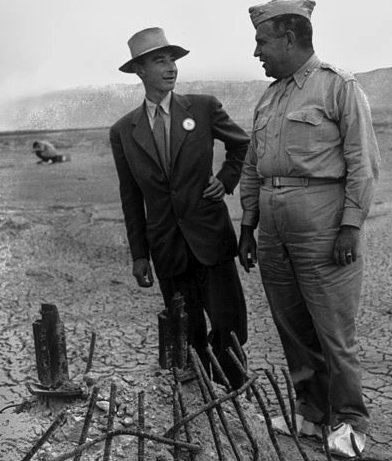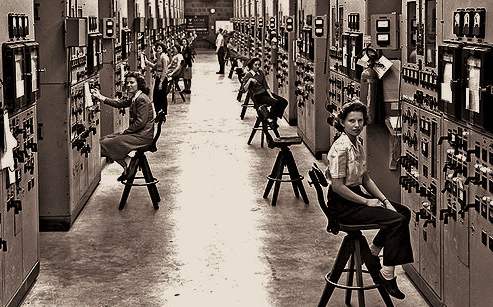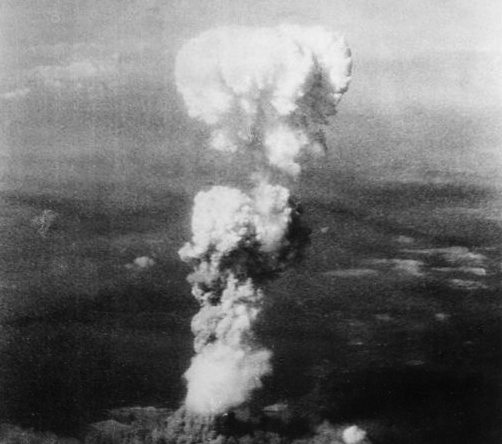Generals and Physicists: The Manhattan Project
Dan Bryan, March 14 2012
 The Trinity test. July 16, 1945
The Trinity test. July 16, 1945"I went to Los Alamos three times, and each time I got to see Dr Oppenheimer working in his own environment. Later, thinking about it, here's a young man, a brilliant person. And he's a chain smoker and he drinks cocktails. And he hates fat men. And General Leslie Groves, he's a fat man, and he hates people who smoke and drink. The two of them are the first, original odd couple." - Paul Tibbets
General Groves: A hard driving taskmaster
Leslie Groves had just spent a year of his life overseeing the construction of a new military headquarters called the Pentagon. In the aftermath of Pearl Harbor, the military was so eager to use the new building that they occupied offices on one side while the other side was being built.
It was no accident that Leslie Groves was the leader of this construction effort. He was known as a doer, a motivator, a task master, a son of a bitch. Groves worked seven days a week overseeing the construction of the Pentagon, and he had no patience for those who couldn't keep up. If he had to wake up at midnight to catch an early train, he wouldn't even so much as stop for breakfast at his destination before he got to work.
His abiding hope through the ordeal of constructing the Pentagon was to receive a combat command. He later said that he was "hoping to get to a war theater so I could find a little peace."
A strange new weapons program
General Groves was sorely disappointed.
Instead of being sent overseas, he was redirected to a new task, and one that was none too familiar to him. He was told that a special form of uranium would be needed -- or plutonium perhaps -- to create a super-bomb. There were five different methods being considered, each with an overly optimistic Nobel laureate to extoll its virtues:
1) Electromagnetic enrichment of uranium
2) Centrifugal enrichment of uranium
3) Gaseous/diffusion enrichment of uranium
4) Graphite reactors, to create plutonium
5) Heavy water reactors, to create plutonium
The challenges were absurd. For just one example, take the notion of electromagnetic enrichment. Ernest Lawrence at Berkeley was working on a device called the "calutron" for this purpose. After extensive testing this device had produced a 30% pure sample of the uranium-235 isotope weighing 75 micrograms!
This, when perhaps a kilogram would be needed to form a usable weapon.
How much uranium-235 does it take to charge a light bulb?
Leo Szilard and Eugene Wigner had drafted a letter to President Roosevelt in 1939. In it they urged an immediate program to develop a nuclear weapon using uranium, lest the Germans do so first. For added credibility they convinced Albert Einstein to sign the letter.
Now in 1942, they worked under the auspices of the US Army to this very purpose. Shortly after he was assigned to head the Manhattan Project, Leslie Groves came to the University of Chicago to view their progress.
While Groves was no physicist, he did have a background in math and he sat patiently while one Nobel laureate after another used the blackboard to apprise him of their situation. He nodded and took notes.
"How much will we need?" Groves asked.
He meant how much enriched uranium would be needed to produce a bomb. With pride, the physicists gave him an answer that was accurate -- within one order of magnitude!
Anything from a tenth of a kilogram to ten kilograms… the formulas explained everything.
Groves became enraged by their assurances. To him, the answer was next to useless. He needed someone who was just a little more grounded in reality.
An organized, broad-minded scientist
J. Robert Oppenheimer oversaw the construction of the atomic bomb.
Oppenheimer was a strange combination of physicist and renaissance man. While many other physicists had irritated General Groves with their idealistic viewpoints, ignorance of industrial production, and overoptimistic projections of uranium yields, Oppenheimer had a wide range of interests and a more sober assessment of the challenges.
 J. Robert Oppenheimer and Leslie Groves at the Trinity test site. The white overshoes are designed to protect the General from radiation.
J. Robert Oppenheimer and Leslie Groves at the Trinity test site. The white overshoes are designed to protect the General from radiation.Grounded in reality is a relative term here. Into the early 1930s, Oppenheimer was completely unaware that there had been a stock market crash. Many of his close friends and even some lovers (and he was a known philanderer) were Communists. The FBI deemed Oppenheimer a security risk and warned General Groves not to let him anywhere close to the Manhattan Project.
Groves built a different impression of Oppenheimer. They sat in the private car of a train and discussed the issues involved with building a bomb, and Groves left the conversation impressed.
Based on personal intuition, Groves disregarded the FBI warnings about Oppenheimer's political connections. This, even though Groves himself despised communism and saw belief in it as a sign of personal weakness.
None of this is to say that the relationship between Groves and Oppenheimer was always smooth. They were polar opposites in many ways, if not most. It was professional duty alone that kept the hulking, conservative general and the skinny, libertine physicist in almost constant contact.
Competing on the "calutrons"
Uranium enrichment eventually proceeded at the town of Oak Ridge, Tennessee. Through endless testing, three methods of uranium enrichment were improved. They were then run in sequence on the same supply of uranium, so that it became progressively more enriched at each step of the process. Usable samples were finally produced.
The industrial efforts needed were immense. Thousands of women were hired from the Tennessee hills to operate the "calutrons". When they produced enriched uranium faster than trained physicists, General Groves ribbed Ernest Lawrence to no end (Lawrence had created the device).
The two agreed to a time trail, without telling any of the participants. They watched as the scientists thoroughly checked the cause of any minor fluctuations to the dials. Meanwhile the "hillbilly" girls followed their instructions to the letter, working without a pause. They were not even aware of what the dials on the machines represented, or of what ends their labor was being used for.
 Many thousands of women enriched uranium with a high school diploma. None of them had a clue what these machines were doing until after the fact.
Many thousands of women enriched uranium with a high school diploma. None of them had a clue what these machines were doing until after the fact.Groves' workers won the time trial, and at the same time confirmed his views that the scientists themselves were poor candidates for certain steps of the production process. He used the opportunity to give the "hillbillies" a morale boost.
Eventually, over a hundred thousand people would work at Oak Ridge, almost all of them in one of the enrichment methods.1
1 - Note that at the same time that uranium was being enriched in Tennessee, reactors were built in Hanford, Washington to create plutonium. Plutonium was the basis for the second bomb, dropped on Nagasaki.
Building the bomb in New Mexico
Meanwhile, construction of the bombs themselves proceeded at Los Alamos, New Mexico. Many talented physicists were politely commandeered to this remote location, where Oppenheimer himself spent most of his time.
Oppenheimer helped select the location. He had long owned a ranch in the area, and he selflessly advocated for this environment on behalf of his fellow physicists, reasoning that the scenic beauty would inspire them as they worked.
Others found the location isolated and stifling. A young Richard Feynman took to dancing and chanting late at night on the mesa, and rumors spread about a mysterious Indian drummer. He also picked several locks when he discovered that their combination was 27-18-28 (e = 2.71828…).
More serious espionage was afoot. Klaus Fuchs was the most notorious spy, but there were others. When Harry Truman informed Joseph Stalin at Potsdam of the successful nuclear weapons test, Stalin already knew.
The long tentacles of the military
Not one important figure in the scientific community worked outside the view of the military.
For instance, a California-Berkeley physics student named David Bohm had produced proton scattering calculations that were useful to the Manhattan Project. His work was classified, and since he lacked security clearance, he was not allowed to defend or even write his own thesis.
Instead of a traditional thesis defense, Bohm had to rely upon the efforts of Oppenheimer, who personally certified to the university that Bohm had completed his research.
Final success: Hiroshima
By mid-1945 it was clear that a working atomic bomb could be produced. The scientists were immediately split on whether to use this creation.
Supporting its use was Oppenheimer himself. Compton, Lawrence, and Fermi were favorable as well. They were in line with prevailing military opinion. Avoiding an invasion of Japan was the overriding preoccupation for everyone in the American chain of command. General Groves himself selected the targets, although his choice of Kyoto was overruled by Henry Stimson.
However, many other physicists were opposed to using the atomic bomb at all. This included Leo Szilard, the man who had suggested the research in the first place. He circulated a petition that gained seventy signatures, and he forwarded it to President Truman. The petition called for restraint in the use of the bomb.
Szilard advocated for a demonstration of the bomb such that Japan would know its power. Only if Japan refused to surrender, he believed, should the bomb then be dropped on civilians.
General Groves was infuriated by Szilard at every turn, and he unsuccessfully looked for ways to try Szilard under the Espionage Act. At the same time, he cracked down on the co-signers, and most of them lost their jobs.
 The "Little Boy" device detonates over Hiroshima - August 6, 1945
The "Little Boy" device detonates over Hiroshima - August 6, 1945Thus on August 6, 1945 the first bomb was dropped on Hiroshima, regardless of the scientists' opinions. It was the final step in the commandeering of their work by the US military.
Recommendations/Sources
- Leo Szilard Online
- Interview with Paul Tibbets
- Stephane Groueff - Manhattan Project: The Untold Story of the Making of the Atomic Bomb
- Leslie Groves - Now It Can Be Told: The Story Of The Manhattan Project
- Richard Rhodes - The Making of the Atomic Bomb
